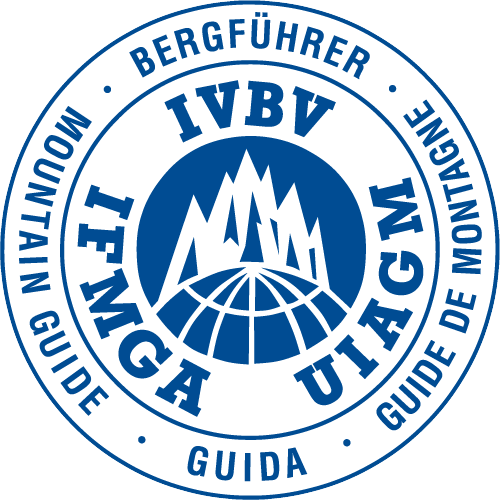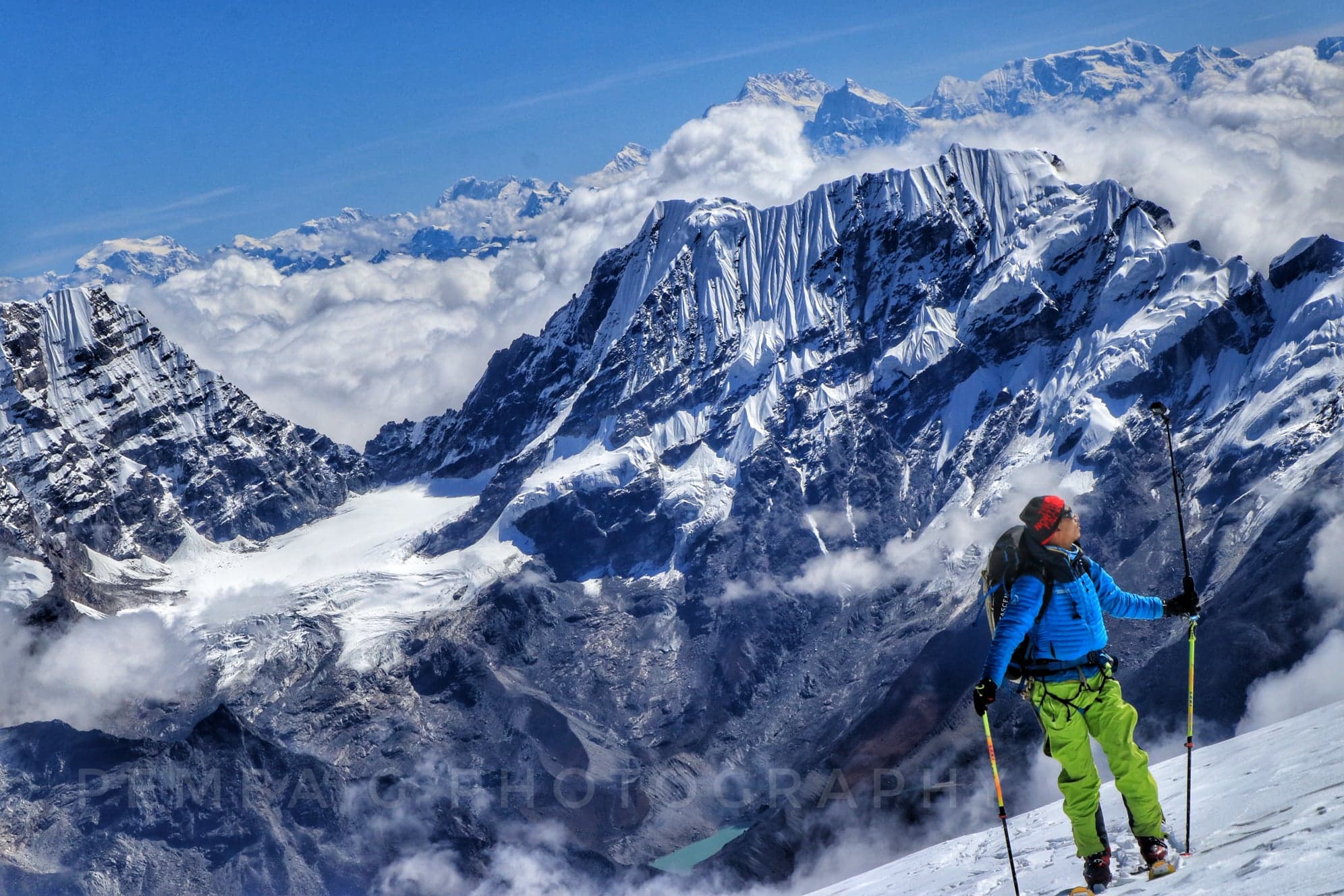

Our team is here to support you 24/7. Please feel free to provide your queries. You will get response within few minutes.




Mera Peak and Island Peak via Amphu Labsta Pass 5700m is the ultimate trekking and climbing challenge in the Himalayas of Nepal. Even reaching the top of one of these fantastic peaks is a great achievement. This Trip includes two 6000+meter peaks and one challenging high pass. This exceptional high-altitude adventure is packed with an amazing variety of mountains and wilderness valleys, forests and grasslands, lodges, and camping: a complete Khumbu experience.
Even though the majority of this expedition is straightforward trekking, it is graded strenuous, as it includes two incredible peaks over 6100 meters, one technically challenging pass, and seven consecutive nights at elevations over 5100 meters. At this altitude, even very basic trails can be a test of endurance. The Mera Peak and Island Peak via Amphu Labsta Pass expedition route has been carefully planned and paced. ‘Rest days’ allow time for the body to adjust to the altitude while you practice mountaineering skills with your guide to prepare you for the next objective.
This expedition starts with climbing the least technical, Mera Peak first, followed by the rather tricky Amphu Labsta Pass, and then a moderately difficult Island Peak, with its exposed summit.
Mera Peak, standing at 6460 m, is the highest trekking peak in Nepal. Neither too steep nor technically difficult, Mera Peak is a great introductory climb to practice the basics of high-altitude climbing skills. This route avoids the steep climb to Zatrwa La pass by making a loop to the south through a beautiful untraveled part of the country and joins the at Kote, allowing time for gradual acclimatization. We fly to Lukla, 2820 m, and trek south to Surke, 2290 m, the same day. We follow the Inkhu River right up to the Mera Peak Base Camp, at the foot of Mera’s north face. The route to high camp goes via Mera La pass. Only the last 30 or 40 meters to the summit require the use of fixed lines. From the summit you get magnificent views of the over-8000-meter-mountains including Mt. Everest, 8848 m, Mt. Lhotse, 8516 m, Mt. Cho Oyu, 8201 m, Mt. Makalu, 8463 m, Mt. Kanchenjunga, 8586 m, to name a few.
Descending from the summit of Mera, the route turns east at the Mera La, into the Upper Hongu Valley. As we follow the valley northward, the rock face of Chamlang towers to the east and Lhotse and Everest are visible directly in front of us. Once we reach the sacred Panch Pokhri lakes, we are about to tackle the toughest objective of the expedition, the Amphu Labsta pass, 5700 m. The succession of ice steps up to the rocky crest calling for a fixed line. From the top, we have to make a 35-meter abseil to reach fixed lines for the next 300 meters of steep descent on snow and rock.
We re-enter the Khumbu which, after so many days in the wilderness, seems busier than before. We will set up a base camp in the Imja Valley, and prepare to summit Island Peak, 6189 m, which lies close to the imposing south face of Lhotse. After the summit, we descend the Everest Trail stopping in the Sherpa capital of Namche Bazaar before completing the circuit trek at Lukla.
We ascend Island Peak via the normal route, directly underneath the imposing southwest face of Lhotse, the fourth-highest mountain in the world. Though lower in altitude than Mera Peak, Island Peak is slightly more challenging. The ascent involves an easy scramble up to a rock ridge and then onto a glacier where fixed lines are used to climb the 45-degree snow slopes leading to the exposed summit ridge. The fabulous summit views include Lhotse, Nuptse, Mt.Makalu, and Ama Dablam. We follow the Chhukkung Valley and join the Everest Base Camp trail at Dingboche, one of many Sherpa settlements we pass through on our return to Lukla.
The best season for Mera and Island Peak Climbing is from March to May (Spring) and from September to November (Autumn). However, the winter is also a great time to climb if you are well prepared for the cold weather. In the crisp and cold month of December, the views of the mountains are crystal clear and there are fewer tourists around. The duration of the Mera and Island Peak Climb can be lengthened or shortened according to your preference. Expedition High Mountain will arrange every detail of your Mera and Island Peak Expedition; lodge accommodation, food, as well as all the necessary climbing and camping equipment.

25 Days Trekking / Peak Climbing / (SKILL LEVEL: extreme)
Day 1 :Arrive in Kathmandu (1,300m/4,265ft)
Day 2 :Preparation Day in Kathmandu 1300m
Day 3 :Fly to Lukla, and trek to Paiya (Chutok),(2,730m/8,956ft) 3-4 hrs
Day 4 :Trek to Pangoma, (2,850m/9,350ft) 5-6 hrs
Day 5 :Trek to Nigmsa (2,745m/9,005ft) 4-5 hrs
Day 6 :Trek to Chhetra Khola, (3,122m/10,242ft) 7-8 hrs
Day 7 :Trek to Kothe, (3,600m /11,811ft) 6-7 hrs
Day 8 :Trek to Thangnak, (4,356m/14,291ft) 5 hrs
Day 9 :Trek to Khare, (5,045m/16,551ft) 4 hrs
Day 10 :Acclimatization Day in Khare /Preparation day
Day 11 :Trek to Base Camp (5,350m/17,552ft) 4 hrs
Day 12 :Trek to High Camp, (5780m/18,963ft) 4 hrs
Day 13 :Mera Peak (6,46m/ 21,246ft) Ascent and Decent to Kongme Dingma (4,900m/16,076ft) 10-12 hrs
Day 14 :Reserve Day
Day 15 :Trek to Hongu river Seto Pokhari (5,000m/16,404ft) 4-5 hrs
Day 16 :Trek to below the Amphu Labtsu high camp (5,400m/17,716 4 hrs
Day 17 :The Amphu Labtsa (5,780m/ 18,963ft) and trek to Imja Valley 10 hrs
Day 18 :Trek to Island Peak Base Camp(5,200m/17,060ft) 2 hrs
Day 19 :Base Camp to Summit 6,189m/20,305ft and descent to Chhukung (4,710m/15,452ft) 10-12 hrs
Day 20 :Trek to Tengbuche, (3,864m/12,677ft ) 4 hrs
Day 21 :Trek to Namche (3,450m/11318ft ) 3hrs
Day 22 :Trek to Lukla (2,810m/9,219ft)
Day 23 :Fly from Lukla to Kathmandu 1300m
Day 24 :Free Day in Kathmandu
Day 25 :Depart Kathmandu.
Remark: – Please note that cloud and turbulent weather is a regular phenomenon in the Himalayan range. It is thus possible that domestic flights from Kathmandu to/from Lukla may be delayed for a few hours or even canceled for a day or more. Fortunately, this does not happen frequently during the high seasons of March to May or September to November: but you need to plan for this possibility.
As a safeguard, we recommend that you add on a couple of extra days after your trek before you fly from Kathmandu to your onward destination.
Day 1: Arrival in Kathmandu (1,300m/4,265ft)
Welcome to Kathmandu, Nepal! Upon arrival at Tribhuvan International Airport, our representative will greet you and transfer you to your hotel in the vibrant capital city. Take some time to rest and adjust to the new time zone. Depending on your arrival time, you may explore nearby areas and immerse yourself in Kathmandu’s rich culture and bustling atmosphere.
Day 2: Preparation Day in Kathmandu
Today is dedicated to finalizing preparations for your trek. Meet your guide and fellow trekkers for a briefing about the upcoming adventure. Ensure all necessary permits and gear are in order. In your free time, you can explore Kathmandu’s ancient temples, markets, and vibrant streets, soaking in the sights and sounds of this culturally rich city.
Day 3: Fly to Lukla and Trek to Paiya (Chutok) (2,730m/8,956ft)
Embark on an early morning flight to Lukla, where your trek begins. The scenic flight offers stunning views of the Himalayas before landing at one of the world’s most thrilling airports. From Lukla, start your trek towards Paiya (Chutok), a picturesque village surrounded by lush greenery and terraced fields. Enjoy a gentle hike to acclimatize to the altitude.
Day 4: Trek to Pangoma (2,850m/9,350ft)
Continue your trek through verdant forests and quaint villages to reach Pangoma. Along the way, you’ll pass through charming Sherpa settlements and enjoy breathtaking views of the surrounding landscapes. Pangoma offers a tranquil atmosphere to unwind and immerse yourself in the natural beauty of the Himalayas.
Day 5: Trek to Nigmsa (2,745m/9,005ft)
Today’s trek takes you to Nigmsa, a serene village nestled amidst rhododendron forests and alpine meadows. The trail offers glimpses of towering peaks and cascading waterfalls as you ascend higher into the mountains. Arrive in Nigmsa and relax at your lodge, enjoying the peace and tranquility of the surroundings.
Day 6: Trek to Chhetra Khola (3,122m/10,242ft)
Set out on a challenging trek to Chhetra Khola, following a rugged trail that winds through rocky terrain and lush valleys. As you gain elevation, you’ll be rewarded with panoramic views of the surrounding peaks. Arrive at Chhetra Khola and rest your weary legs after a long day of trekking.
Day 7: Trek to Kothe (3,600m /11,811ft)
Continue your journey towards Kothe, a small settlement nestled along the banks of the Dudh Koshi River. The trail offers stunning views of waterfalls, glaciers, and snow-capped peaks as you make your way through the pristine wilderness. Arrive in Kothe and relax at your lodge, surrounded by the natural beauty of the Himalayas.
Day 8: Trek to Thangnak (4,356m/14,291ft)
Today’s trek takes you to Thangnak, a picturesque village situated in a remote valley surrounded by towering mountains. The trail winds through rocky terrain and glacial moraines, offering breathtaking views at every turn. Arrive in Thangnak and enjoy a peaceful evening surrounded by the majestic Himalayas.
Day 9: Trek to Khare (5,045m/16,551ft)
Continue your ascent towards Khare, the last settlement before reaching Mera Peak Base Camp. As you climb higher into the mountains, the trail becomes steeper, with panoramic views of snow-capped peaks dominating the landscape. Arrive in Khare and prepare for the challenges ahead as you approach Mera Peak.
Day 10: Acclimatization Day in Khare
Today is a rest day in Khare to allow your body to acclimatize to the high altitude. Take a short hike around the village or simply relax and enjoy the stunning mountain views. Use this day to prepare yourself mentally and physically for the upcoming climb.
Day 11: Trek to Mera Peak Base Camp (5,350m/17,552ft)
Embark on a thrilling trek to Mera Peak/ Base Camp, where your summit attempt will begin. The trail ascends steadily through rocky terrain and glacial moraines, offering unparalleled views of the surrounding peaks. Arrive at Base Camp and rest, preparing for the challenging days ahead.
Day 12: Trek to High Camp (5780m/18,963ft)
Continue your ascent towards Mera Peak High Camp, the launching point for your summit push. The trail becomes increasingly steep and challenging as you climb higher into the thin air. Arrive at High Camp and rest, hydrate, and fuel up for the summit attempt.
Day 13: Mera Peak Ascent (6,46m/ 21,246ft) and Descent to Kongme Dingma (4,900m/16,076ft)
Today is the big day – summit day! Rise before dawn to begin your ascent of Mera Peak, the highest trekking peak in Nepal. Climb steadily towards the summit, using ropes and crampons to navigate the icy slopes. Reach the summit and savor the breathtaking views of the surrounding Himalayan giants. Descend carefully back to High Camp and continue your descent to Kongme Dingma for a well-deserved rest.
Day 14: Reserve Day
Today is a reserve day in case of inclement weather or unforeseen circumstances during the summit attempt. Use this day to rest and recover, or explore the surrounding area if conditions allow. Alternatively, enjoy a leisurely day in Kongme Dingma, soaking in the tranquility of the mountains.
Day 15: Trek to Hongu River Seto Pokhari (5,000m/16,404ft)
Resume your trek with a descent to the Hongu River Seto Pokhari, a pristine alpine lake nestled amidst towering peaks. The trail winds through rocky terrain and lush forests, offering stunning views of the surrounding landscapes. Arrive at Seto Pokhari and relax by the shimmering waters, surrounded by the beauty of the Himalayas.
Day 16: Trek to below the Amphu Labtsa High Camp (5,400m/17,716 ft)
Continue your journey towards the base of Amphu Labtsa Pass, a challenging mountain pass that connects the Hongu and Imja Valleys. The trail ascends gradually through rocky terrain, with panoramic views of the surrounding glaciers and peaks. Arrive at the base camp and prepare for the pass crossing tomorrow.
Day 17: Cross the Amphu Labtsa Pass (5,780m/ 18,963ft) and Trek to Imja Valley
Today is a challenging day as you cross the Amphu Labtsa Pass, navigating steep slopes and icy terrain. Use ropes and crampons to safely traverse the pass, taking in breathtaking views of the surrounding peaks. Descend carefully into the Imja Valley, where you’ll rest and celebrate the successful pass-crossing.
Day 18: Trek to Island Peak Base Camp (5,200m/17,060ft)
Continue your trek towards Island Peak Base Camp, the starting point for your summit attempt. The trail winds through rocky terrain and glacial moraines, offering stunning views of the surrounding peaks. Arrive at Base Camp and rest, preparing for the challenging climb ahead.
Day 19: Island Peak Summit (6,189m/20,305ft) and Descent to Chhukung (4,710m/15,452ft)
Rise before dawn for your ascent of Island Peak, one of the most iconic climbing challenges in the Everest region. Climb steadily towards the summit, navigating steep slopes and crevasses with the help of your experienced guides. Reach the summit and enjoy breathtaking views of Everest, Lhotse, and Makalu. Descend carefully back to Base Camp and continue your descent to Chhukung for a well-deserved rest.
Day 20: Trek to Tengbuche (3,864m/12,677ft)
Resume your trek with a descent to Tengbuche, a tranquil village renowned for its ancient monastery and stunning views of Everest and Ama Dablam. The trail descends through rhododendron forests and quaint villages, offering glimpses of Sherpa culture and tradition. Arrive in Tengbuche and visit the monastery, soaking in the peaceful atmosphere.
Day 21: Trek to Namche (3,450m/11318 ft)
Continue your descent towards Namche Bazaar, the bustling heart of the Khumbu region. The trail winds through lush forests and terraced fields, with panoramic views of the surrounding mountains. Arrive in Namche and spend the afternoon exploring the vibrant markets and bakeries, or simply relaxing and enjoying the mountain views.
Day 22: Trek to Lukla (2,810m/9,219ft)
Today marks the final leg of your trek as you descend towards Lukla, where your journey began. Enjoy your last day of trekking as you pass through charming villages and verdant valleys. Arrive in Lukla and celebrate the successful completion of your trek with your fellow trekkers.
Day 23: Fly from Lukla to Kathmandu
Bid farewell to the mountains as you board a scenic flight from Lukla to Kathmandu. Enjoy breathtaking views of the Himalayas during the short flight before landing at Tribhuvan International Airport. Transfer to your hotel and spend the rest of the day relaxing and reflecting on your incredible journey.
Day 24: Free Day in Kathmandu
Today is a free day to explore Kathmandu at your own pace. Visit cultural landmarks such as Durbar Square, Swayambhunath Stupa, or Pashupatinath Temple, or simply wander through the bustling streets and markets. Alternatively, you may choose to relax at your hotel or indulge in some last-minute souvenir shopping.
Day 25: Departure from Kathmandu
All good things must come to an end, and today marks the conclusion of your adventure in Nepal. After breakfast, transfer to Tribhuvan International Airport for your onward journey. Take with you cherished memories of the Himalayas and the friendships forged along the way. Safe travels, and until we meet again!
| Climbing Gear | ● Ice Axe With Leash
● Crampons ● Climbing Harness ● Carabiners ● Ascender (Jumar) ● Belay Device ● Prussiks ● Trekking Poles ● Helmet |
| Headwear | ● Headlamp (Min. 200 Lumens) With Sufficient Batteries (Li-Ion Batteries)
● Sunglasses (Polarized/ Uv Protected) ●Woolen Cap ● Sunhat ● Buff Scarf ● Balaclava |
| Bodywear (Clothing/Layering) | ● Down Suit
● Down Jacket ● Down Pant ● Gore-Tex Set \ Hardshell Set ● Insulated Mid Layer ● Fleece Jacket ● Thermal Set ● Quick Dry (Half and Full Sleeved) ● T-Shirts ● Trekking Trousers ● Additional As Per Necessity |
| Handwear | ● Liner Gloves
● Fleece Gloves ● Expedition Gore-Tex Gloves (Heavy Duty) ● Mittens |
| Footwear | ● Trekking Shoes
● Expedition Climbing Shoes (7000er Series) ● Camp Shoes/ Slippers ● Gaiters ● Liner Socks ● Woolen Socks/ Trekking Socks ● Summit Socks (7000er Series) |
| Personal Kit | ● Trekking Backpack
● Sleeping Bag -30℃ ● Hygiene Kit (Toiletries) ● Sun Screen (Min. 50 Spf) ● Lip Guard ● Water Bottle ● Thermos |
| First Aid Kit | ● Personal Medications
● Personal First Aid Kit |
| Miscellaneous | ● Camera And Associated Gears
● Camp Knife/ Multi Tools ● Binoculars/ Magnifiers ● Personal Reading Accessories ● Games And Entertainment Mediums ● Pee Bottles ● Dry Bag/ Compression Bags |